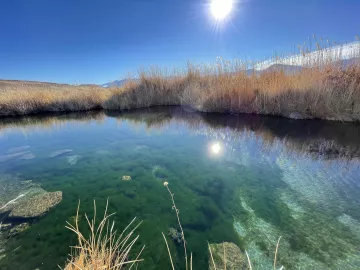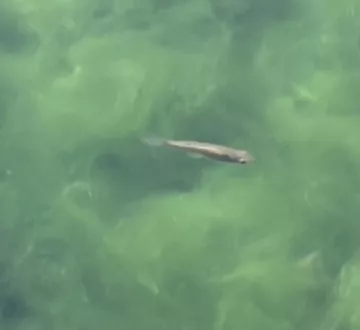By Chris Bubser
Most of us know the legend of how Phil Pister saved the Owens Pupfish in August of 1969. But I wanted to know more, so I listened to two hours of interviews with Phil recorded in December of 1991 for the Eastern California Museum. What a gift these recordings turned out to be. Phil was best known for his vast knowledge of the biology of the area, but he also expressed his opinions about things as varied as the civil rights tragedy of the internment of his Japanese friends in Stockton who were taken to Manzanar. He said, “People do tragic things when wars start.” He also talked about how different the area would be if LA had not bought up all the land in order to build the aqueduct. It’s a point that I found thought provoking.
Edwin Philip “Phil” Pister had a wealth of knowledge about the Eastern Sierra, gained from a lifetime of experience, both as a child exploring the backcountry with his family, and from his half-century career as a fishery biologist with the California Department of Fish and Game. Phil was born and raised in Stockton, California. The child of a teacher, his family spent entire summers in the 1930s in Tuolumne Meadows. His recollections of his youth in the Sierra are engaging and I highly recommend spending a few hours with Phil here. When he was a freshman at Berkeley, he and his brother began backpacking in the Eastern Sierra. After graduating from Berkeley, studying under Aldo Leopold and becoming a student of Environmental Philosophy, Phil settled in Bishop, California and began his long career.
Phil had an encyclopedic knowledge of the Eastern Sierra. Due to the fact that his training was as a student of limnology, the study of freshwater lakes, he was responsible for more than one thousand waters across 10 million acres from the crest of the Sierra to the Nevada state line. Although the Eastern Sierra is well known for fishing, there are only four native fishes in the Owens Valley, and none of them are Eastern Brook Trout. Along with saving the pupfish, Phil worked to protect the Golden Trout, the closest thing to a native trout in Inyo County. The Golden Trout were native to the Kern River and were brought to Cottonwood Creek in 1876. He goes on to share great detail about the hatcheries, when various fish were introduced and the effects and consequences.
He shared recollections of many of his colleagues including Elden Vestal, who lived at June Lake, and whose recollections provided key court testimony that made a major difference in the Mono Lake decisions. When asked what tools they had to protect species before the Endangered Species Act (signed in December 1973), Phil said, “The only tool you had was your own conscience.”
So back to the Pupfish. For those who do not know the story of how the Owens Pupfish were saved, here it is in Phil’s own words from a 2015 article in American Currents.
“Of more than ten thousand entries contained in my diaries, the date August 18, 1969, stands alone as the most dramatic and meaningful. Written with naive understatement:
"Transplanted Cyprinodon at Fish Slough; purchased alkaline D-cells, $2.00,” this cryptic entry summarized a series of events that, had they not gone right, would have accompanied the greatest tragedy of my career.
An unusual set of circumstances that began to coalesce in the late 1960s brought the Owens Pupfish to the brink of extinction. The winter of 1968-69 had brought heavy rains to the Owens Valley, but by August the unusually thick vegetation was throwing off a great deal of moisture, and an unexplained reduction in spring flow contributed to the rapid depletion of the pond. It was almost completely dried up when an alert assistant came into my office and announced: “Phil, if we don’t get out to Fish Slough immediately, we are going to lose the species.” His pronouncement was no exaggeration. It was the hard truth!

Grabbing buckets, dip nets, and aerators, we were joined by another colleague and immediately headed for Fish Slough. We hastened to the drying pond and carefully removed 800 remaining individuals, placing them in three wire mesh cages within the main northwest channel of the slough, in a diminishing flow already less than two cubic feet per second. We planned to move them later to safer locations within the same general area. Having done all we could for the moment, we decided to take a quick dinner break before returning to move half of the fish (about 400) across the slough to a location supplied by another spring source. In endangered species preservation work, a cardinal rule is always to place your eggs in more than one basket. Temporarily alone in the marsh, I decided to make one final check (sometimes it pays to be a worrier). A glance into the nearest mesh cage showed that we were not yet out of the woods. A number of dead and dying fish were already floating belly up or swimming irregularly, and it was clear that both mesh cages and fish would have to be moved immediately upstream to more favorable conditions nearer the springheads. I ran to my pickup truck and found only two buckets (the other two were on their way back to town). However, there were two aerators available in addition to the all-important dip net. I netted the surviving fish into the buckets, wincing as each dead one forcefully demonstrated the fragility of life. I then relocated the cages and returned to the buckets, trusting that the battery-powered aerators had not failed during my brief absence. Although the passage of time has obscured my exact words and thoughts as I lugged two heavy buckets and their precious cargo (each weighing more than thirty pounds) over the treacherous marsh terrain, I remember mumbling something like: “Please don’t let me stumble. If I drop these buckets we won’t have another chance!” I distinctly remember being scared to death. I had walked perhaps fifty yards when I realized that I literally held within my hands the existence of an entire vertebrate species. If I had tripped over a piece of barbed wire or stepped into a rodent burrow, the Owens Pupfish would now be extinct! But good fortune smiled upon us, and the recovery continues today.”

Credit: Chris Bubser
Among the many awards Phil received were the following:
- Order of the Jassid (for conservation) from Sierra Pacific Flyfishers
- President's Fishery Conservation Award from the American Fisheries Society
- The Edward T. LaRoe III Memorial Award from the Society for Conservation Biology
- 2018 Andrea Lawrence Award from the Mono Lake Committee
Phil died in Bishop on January 17, 2023. Now it’s time for the rest of us to protect his legacy.